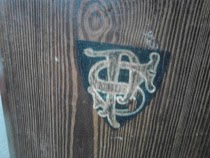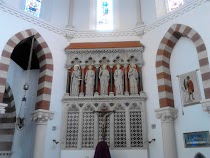St Pancras Church, Ipswich
| St Pancras, Ipswich | |
|---|---|
| Saint Pancras | |
Ipswich Deanery | |
| Clergy | |
| Bishop(s) | Alan Hopes |
| Priest(s) | Joseph Welch |
Saint Pancras is an active Roman Catholic parish church serving the town centre of
Building and dedication of the church

The construction of St Pancras was largely financed from the estate of L'Abbé Louis Simon. Abbé Simon was a French émigré priest who came to Ipswich in 1793, during the French Revolution, and became the first Catholic priest to celebrate Mass regularly in Ipswich since the Reformation.[2] Simon was from an aristocratic family in Normandy and sold property he inherited in Normandy to fund church building in his adopted home of Ipswich.[2]
The church was built by
History

Two years after the church was consecrated, in 1863, St Pancras was the target of a series of
In 1919 St Mary's split from St Pancras to become its own parish.
In 1976 St Pancras, with all the other Catholic parishes in Suffolk, was transferred to the new
Architecture and fittings
St Pancras is a
The main altar is at the east end of the church. Behind the altar are
The
Beneath the choir loft and behind wrought iron gates is a
The
To the west of the church is the
References
- ^ a b c d St Pancras celebrates 150 years, BBC website
- ^ a b c d e f g From the Church archives, St Pancras parish website
- ^ a b c d e f g Historic England. "Details from listed building database (1264101)". National Heritage List for England. Retrieved 20 April 2007.
- ^ a b St Pancras, Official parish site
- ^ St Pancras, Ipswich, suffolkchurches.co.uk, Simon Knott
- ^ a b St Pancras Catholic Church, from ukattraction.com
- ^ a b c Centenary Guide and Souvenir, St Pancras Church Ipswich, 1961, published by St Pancras Church
- ^ Old church of St Mary, Ipswich, Suffolk Churches
- ^ St Mark, Ipswich, Article from the Suffolk Churches website
- ^ New at Ipswich, from the Catholic Herald
- ^ "THE POLISH CATHOLIC COMMUNITY IN IPSWICH" (PDF).
- ^ "Diocese of East Anglia". Catholic-Hierarchy.org. David M. Cheney. Retrieved 21 January 2015.
- ^ a b c d Church History, St Pancras Church website
- ^ St. Pancras, Public Commissions, Danielle Hopkinson business website
- ^ From the account of the unveiling in the East Anglian Daily Times, 13 November 1922. ST PANCRAS RC CHURCH, from the War Memorials Archive
- UK National Inventory of War Memorials reference 4634, ST PANCRAS RC CHURCH, from the War Memorials Trust
- ^ "Our Lady of Czestochowa, from the crew of the Polish 'C' Armoured Train - War Memorials Online". www.warmemorialsonline.org.uk.
- ^ "Catholic Herald - Archives".
External links
 Media related to Saint Pancras Church, Ipswich at Wikimedia Commons
Media related to Saint Pancras Church, Ipswich at Wikimedia Commons

